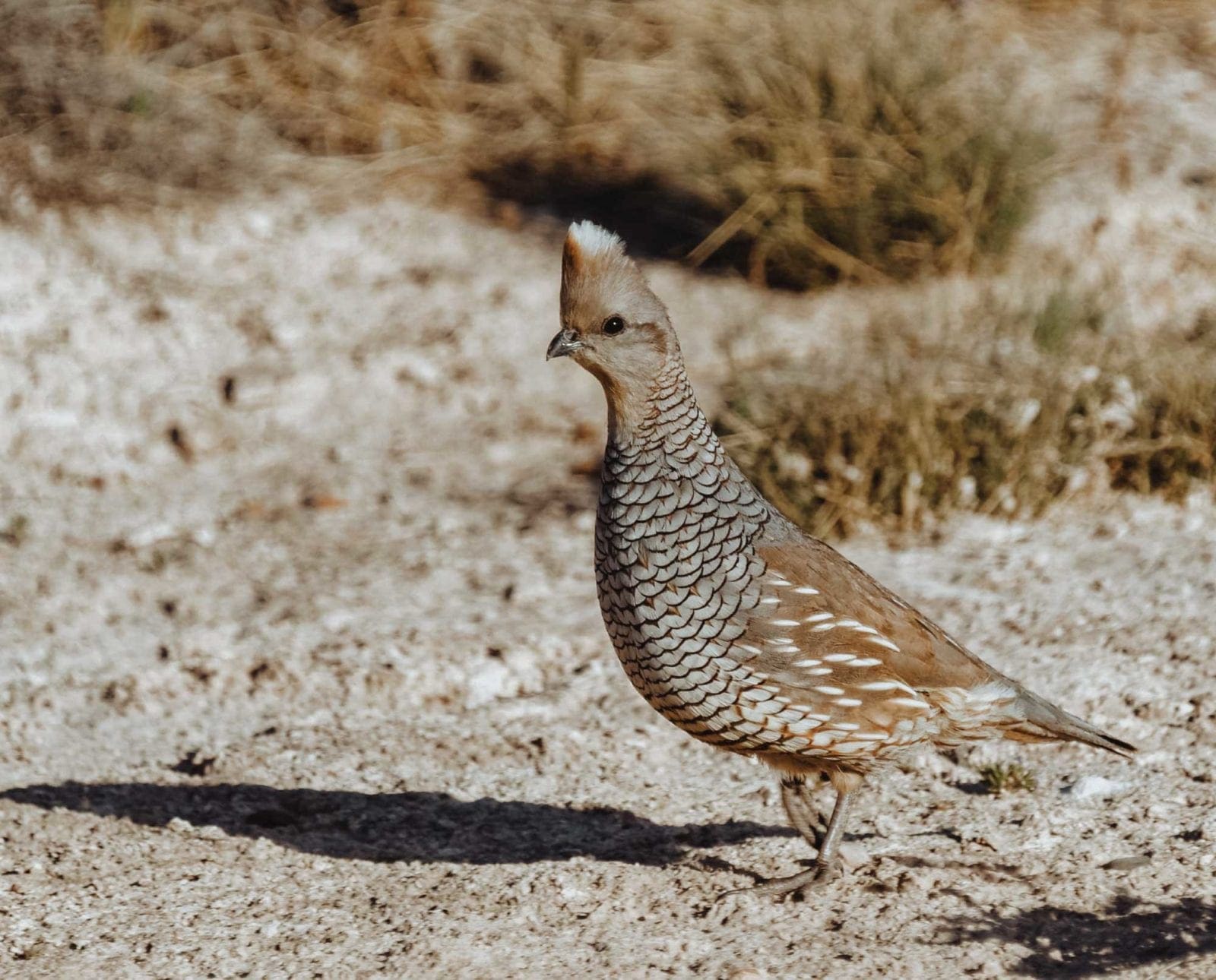Home » Quail Species » Scaled Quail Hunting » Scaled Quail (Callipepla squamata) – Life History of the Blue Quail
Scaled Quail (Callipepla squamata) – Life History of the Blue Quail

Ryan Lisson is a biologist and regular content contributor to…
Chasing the desert quail of the arid southwest
The scaled quail (Callipepla squamata) is a bird of our southwest grasslands, and its appearance really lives up to its name. Although it is closely related to the California quail and Gambel’s quail, there are a couple differences between the species. The scaled quail is also known as the blue quail due to its feather coloration or “cotton-top” quail due to the bright white tuft of feathers on top of its head. Here are some interesting facts about this small quail species, and where you can find them.
Description and life history of the scaled quail
The scaled quail is similar to the other species in size but has a distinct coloration and feather pattern. It has a plump body, short tail, short legs and a small crested head. Both males and females are very well camouflaged with brown or bluish-gray feathers around their head, neck and wings. Their wings also have creamy white wing bars. Their breasts and undersides are white, black, and extremely scaly-looking, hence their name (All About Birds 2019). As mentioned, they have a short brown and white crest on top of their head.
Beginning in mid-winter, males start perching on fence posts and shrubs to make loud one-noted calls to attract a female and defend its territory (NatureServe 2019; All About Birds 2019). After breeding, males and females both build their nests on the ground surrounded by thick cover, including small shrubs, yucca plants, mesquite, tumbleweed, Russian thistle, sand sagebrush, cactus, acacia, soapweed, and even dirt mounds or rocks (All About Birds 2019; National Audubon Society 2019). The nests usually measure about 9 inches across and are made by scratching a depression into the ground and lining it with grass and leaves (All About Birds 2019). Females usually lay 5 to 16 light brown eggs, which they incubate for 22 to 23 days (NatureServe 2019; National Audubon Society 2019). After hatching, the chicks feed themselves but are guided by the parents. Second broods are uncommon unless the food supply is plentiful and the conditions are right.
As fall approaches, the scaled quail begin forming small coveys of 20 to 40 birds for the winter (NatureServe 2019). They typically roost on the ground at night by forming small circles with their heads all facing outward to detect predators. When pressured, they seem to run more often than fly. They tend to feed mostly between dawn and 10 a.m. and between 4 p.m. and dusk (NatureServe 2019). Their diet is mostly seed-based, including those from snakeweed, Russian thistle, broomweed, and mesquite (National Audubon Society 2019). However, they also feed on green leaves, insects, berries, and grain (NatureServe 2018; National Audubon Society 2018).
The scaled quail relies on its camouflage to hide itself and its eggs from predators, which include coyotes, hawks, roadrunners, magpies, snakes and skunks (NatureServe 2019).
Range and habitat of the scaled quail
The scaled quail occurs throughout western Texas, western Oklahoma, southern Colorado, most of New Mexico, and southeast Arizona, as well as much of interior Mexico (National Audubon Society 2019; NatureServe 2019). Where their ranges overlap, scaled quail habitat tend to be open, while Gambel’s quail and northern bobwhites use denser or more shrub-dominated habitats.
The scaled quail mostly use arid, desert grasslands and shrublands within their range. They seem to respond best to mixed habitat types, and populations decline as the vegetation becomes strictly grassland or shrubland alone (NatureServe 2019). Likely habitats include open plains, rolling hills and mesas (up to about 7,000 feet elevation) with acacia, sagebrush, cacti, mesquite, yucca and pinyon-juniper woodlands (All About Birds 2019; NatureServe 2019). They prefer areas of open ground beneath or adjacent to structure and cover.
Conservation issues for the scaled quail
The scaled quail population as a whole is secure across its range (NatureServe 2019). The global breeding population is estimated to be about 5 million birds, with about 48 percent occurring in the United States and 52 percent in Mexico (All About Birds 2019). However, their population has declined approximately 57 percent since 1966 (All About Birds 2019). Similar to the bobwhite quail, scaled quail are primarily threatened by habitat loss due to overgrazing, especially during drought years. Year-round grazing can destroy food resources and cover that quail desperately need in times of drought (All About Birds 2019). Spring and summer rainfall is also important for producing enough cover and food. With the overall reduction in habitat, coveys likely come in closer contact with each other, which could increase the chance of spreading parasites like eyeworm. However, it’s not likely that this has a major effect at this time. Generally, scaled quail do not live long and their populations can completely turn over within six years (NatureServe 2019). Hunting is not believed to be a significant factor in their population cycle.
Hunting opportunities for the scaled quail
You can hunt the scaled quail in a handful of southwest states, including Arizona, Colorado, Kansas, Oklahoma, New Mexico, and Texas. Note that some states have different zones with different season dates, so do your homework to know the actual legal season where you will be hunting.
| State | Season* | Season/Possession Limit |
| Arizona | October 19-February 10 | 15 Per Day/45 Possession Limit |
| Colorado | November 10-January 31 | 8 Per Day/24 Possession Limit |
| Kansas | November 10-January 31 | 8 Per Day/32 Possession Limit |
| Oklahoma | November 10-February 15 | 10 Per Day/20 Possession Limit |
| New Mexico | November 15-February 15 | 15 Per Day/30 Possession Limit |
| Texas | October 27-February 24 | 15 Per Day/45 Possession Limit |
*Maximum season – different zones may have different dates
Mornings and evenings are the best times to be hunting scaled quail since that’s when they are most active feeding. Mornings, however, are generally more agreeable in these areas since you might have to walk 10 or more miles — not an exciting prospect when the temperature climbs high in the afternoon.
As with other quail species, a 20- or 28-gauge shotgun with an improved cylinder or modified choke is the way to go since these birds are not very big and lugging a heavier shotgun around is unnecessary. Using No. 6 shot is usually plenty for scaled quail as well.
Pointing dogs are a real lifesaver when it comes to this quail species. As mentioned above, they tend to scatter and run instead of taking to the sky when they are pursued. In the thick ground cover they like to live in, you will likely walk right by birds without even knowing it. Having a good dog that can sniff them out and point will help you flush more birds and put a few more in the vest.
Sources:
All About Birds. 2019. Scaled Quail. Accessed at: https://www.allaboutbirds.org/guide/Scaled_Quail/lifehistory
National Audubon Society. 2019. Guide to North American Birds. Accessed at: https://www.audubon.org/field-guide/bird/scaled-quail
NatureServe. 2019. NatureServe Explorer: An online encyclopedia of life. Accessed at http://explorer.natureserve.org
Ryan Lisson is a biologist and regular content contributor to several outdoor manufacturers, hunting shows, publications, and blogs. He is an avid small game, turkey, and whitetail hunter from northern Minnesota and loves managing habitat almost as much as hunting. Ryan is also passionate about helping other adults experience the outdoors for their first time, which spurred him to launch Zero to Hunt, a website devoted to mentoring new hunters.



